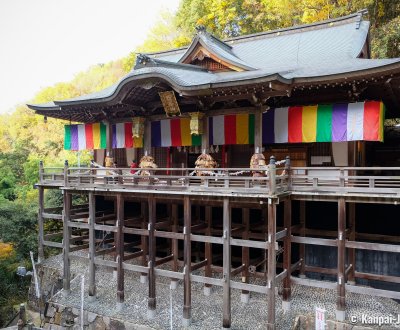Tanukidani-san Fudo-in
The Mountain of Good Health
Tanukidani-san Fudo-in is a Buddhist temple perched on the heights of Ichijoji district in the north-east of Kyoto. Dedicated to the Tanuki raccoon dog and to the wisdom deity Fudo Myoo, the site shelters several pavilions scattered throughout the sacred mountain, immersed in an enchanting and timeless atmosphere.
The heights of Kyoto still have a few surprises in store such as forsaken sites in the mountains with an uninterrupted spiritual aura. Tanukidani-san Fudo-in is one of them, and while it is not well-known by tourists it harbors a thriving cult to:
- Fudo Myoo, one of the 5 Wisdom Kings, the embodiment of immutability, and,
- The tanuki, the famous sacred raccoon dog that bring good fortune.
The temple was built more than 300 years ago around a natural cave discovered by monk Mokujiki Shozen Tomoatsu. In the main hall, a Fudo Myoo statue is shrouded in darkness, and its wrathful attitude is accentuated by its glimmering eyes. Fire 🔥 purification rituals (goma) are held all year long with Hiwatari Matsuri festival on July 28 as a highlight, where priests perform fire walking rituals.
On a daily basis, people pray at Tanukidani-san Fudo-in for:
- Road safety, at a dedicated pavilion located in front of a parking where one parks the car to have it blessed, and,
- Good health, with specific votive plates called gankake fuda, that are used to surround the part of the body to heal or that is damaged (cancer, chronic pain, injury, etc.)

A 250-steps stairway
The Buddhist enclosure spreads on the side of the mountain and one must be in good shape to climb the 250 steps to reach the various buildings. Along the way, hundreds of tanuki ceramic statues with funny expressions and attitudes, Jizo statues, the 7 Lucky Gods and signs showing how many steps are left to the top are displayed.
The climb is worth the effort to immerse in the spirituality exuding from the mountain and its nature that remained almost untouched. Like a small pilgrimage, you follow the steps of the yamabushi ascetics who trained here in the past, such as swordsman Miyamoto Musashi (1584 - 1645) who spent time under one of the temple’s waterfalls to master his two-swords technique. In mid-way, the statue of the benevolent monk Omukae Daishi welcomes visitors who can hang on it the kenkyaku waraji, straw sandal like amulet, to keep their feet in good health.

Kiyomizu-dera’s little brother
Tanukidani-san Fudo-in’s main hall is adorned by a large stilt terrace (butai) like the very famous Kiyomizu-dera. The current building, of kengai-zukuri architectural style – meaning overlooking the landscape, dates back to 1986. The platform gives a view on the houses of northern Kyoto surrounded by forestry mountains.
While it is hidden in a thick forest, the aerial aspect of the temple is highlighted by its stilt architecture, its location on a height and an unobstructed view on the horizon. The visit is recommended all year round, in any season, but preferably on a very sunny day. The low attendance guarantees a quiet discovery, with room for recollection and beautiful sceneries of Buddhist statues.
To return to the bustling city, walk back to the area of Ichijoji station, that connects to Kyoto’s center, or visit the surroundings’ popular temples such as Shisen-do and Enko-ji.

